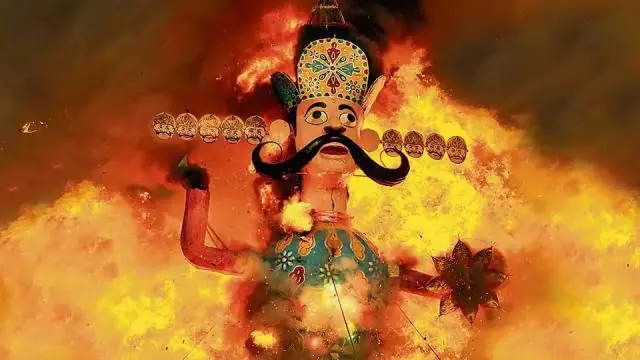Tales And Traditions of Vijayadashami
Vijayadashami, also known as Dasara or Dussehra, is celebrated on the tenth day (Dashami) of Shukla Paksha (first fortnight) of Ashwin month, the seventh month of the Hindu calendar. In India, people celebrate this day with great interest and enthusiasm. From ancient times various rituals have been followed faithfully and religiously.
This article highlights the day’s importance, some of the tales of Dasara, a few references from Hindu Puranas (epics) and the reason behind following certain traditions.
The festivities begin from Ghatsthapana on Pratipada, the first day of Ashwin month. People worship different avatars (incarnations) of Goddess Parvati during Navratri. On Khande Navami, the ninth day, they perform Ayudh Pooja, wherein they worship weapons, tools, study material, machinery, vehicles, etc.
The next day is Vijaya Dashami. It is one of the three and a half most auspicious muhurtas for starting any good work, buying properties and other valuables. On this day, people distribute Apta leaves and perform Aparajita Devi Pooja, Simollanghan, Shami Pooja, etc., which are discussed further in this article.

Reference In Ramayana
On Vijayadashmi, lord Ram defeated Ravana and destroyed Lanka to free Sita from Ashokvana. Although Ravana was a mighty and great devotee of lord Shiva, he misused his intellect, power, and boons or blessings to fulfil his evil wishes. Ultimately when he abducted and jailed Sita, Ram fought Ravana for Sita and shattered his ego by killing him. Vijayadashami is the celebration of this victory of good over evil. Ravan Dahan is performed at many places to convey the message of eliminating one’s evil thoughts, behaviours and actions and walking on the rightful path.
Aparajita Pooja
Before his expedition to Lanka, lord Ram had worshipped Goddess Aparajita on Vijaya Dashmi. There is a belief that the blessings of Goddess Aparajita helped fulfil the purpose of his journey, and hence the ritual of performing Aparajita Pooja is being followed even today.
Distributing Apta Leaves
There are different versions of the tale about why Apta leaves, scientifically known as Bauhinia Racemosa, are worshipped as gold and distributed among dear ones on Vijayadashami, wishing each other success and prosperity.
According to sources during Treta Yug, Kautsya (referred to as Kauras as well), shishya (student) of Rishi Varatantu, wished to offer Guru Dakshina (fees) on completing his education. He went to king Raghu of Ayodhya, great grandfather of lord Ram, asking for alms. The king asked him to wait near Shami and Apta tree and then prayed to lord Kubera, the deity of wealth. Kautsya stayed under the trees for three days. Seeing his dedication, lord Kubera turned Apta leaves into gold and showered them upon him. He collected golden leaves and went to Rishi Varatantu to offer them as Guru Dakshina. Being satisfied with Kautsya’s knowledge and skills as a student, Rishi Varatantu refused to accept them. Since it was Guru Dakshina, Kautsya couldn’t keep it, and because king Raghu had donated it to Kaustya, he couldn’t take it back too. Hence he left those leaves under those trees and asked other people from the village to take them as much as they wanted. It is known as ‘looting gold’. From that day onwards, Apta leaves have significance on Vijayadashami as it represents gold. There is the custom of looting Apta leaves, bringing them home and then distributing them. The story highlights King, Teacher and Student’s ideals of duties and responsibilities. And conveys a message ‘not to be greedy of what is donated’.

Besides religious beliefs, the leaves have scientific importance as they have medicinal qualities as per Ayurveda and treat various ailments.
Reference in Mahabharata
After finishing twelve years of exile and two years of anonymity, Pandavas recovered their weapons hidden in the Shami tree on Vijaya Dashmi. There is the belief that the tree blessed the weapons with victory, and later, Pandavas won the battle of Kurukshetra against Kauravas. And hence Shami tree has particular importance on the day and is worshipped on Vijaya Dashmi.
Devi Durga’s Vijayotsav
During nine days of Navratri, Goddess Durga killed asuras (demons) like Mahishasur, Chand, Mund, Raktabeej, Shumbh, Nishumbh, and many others, making the world a fearless and better place. On the tenth day, they celebrate the victory after nine days of battle, the Vijayotsava (celebration of triumph) of her victory over evil.
Simollanghan
During the old times, they worshipped weapons on Navami before the war and prayed for Goddess Durga’s blessings. Kings and worriers crossed their borders and set to battle on Vijayadashami. Today there are no wars, but we still fight with some evils, such as lust, anger, ego, envy, etc. The tradition of simollanghan is a reminder to believe in good and overcome the evil within us. It is one’s conviction to start a journey from bad to good, failure to success, ignorance to enlightenment.
Although these tales have various versions, they all convey good teachings and set examples of living a life in a better and moral way. On this auspicious and historic day, let us head towards a righteous way of living and wish each other success and prosperity.
